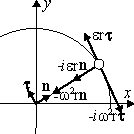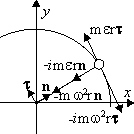7. Kinematics-Dynamics of Non-uniform Circular Motion-Rest
L. G. Kreidik (translation from Russian T. S. Kortneva and G. P. Shpenkov)
In a general case of non-uniform revolution of the system of material points, potential-kinetic projections of motion of the points along the axes x and y has the form
![]() ,
(2.166)
,
(2.166)
![]() , (2.166Ó)
, (2.166Ó)
where r is the distance to the axis of revolution, cp is the angular displacement.
The potential-kinetic velocity of motion of the points
![]() (2.167)
(2.167)
has a structure of uniform motion but acceleration here acquires an additional term, reflecting the non-uniform aspect of the motion:
![]() , (2.168)
, (2.168)
where ![]() is
a potential-kinetic radius.
is
a potential-kinetic radius.
The first term in the right-hand side is qualitative acceleration, acceleration of self-motion, a measure of uniform motion. The second term is quantitative acceleration, acceleration of non-self-motion, a measure of non-uniform motion. Thus, non-uniform circular motion is contradictory, being uniform-non-uniform. This statement is evidently valid for any non-uniform motion.
The terms in the expression for acceleration (2.168) will be rearranged as follows:
![]() , (2.169)
, (2.169)
![]() (2.169Ó)
(2.169Ó)
is normal potential-kinetic acceleration;
![]() (2.169b)
(2.169b)
is tangential potential-kinetic acceleration.
In expression (2.169a), the first term ![]() is
the centripetal potential acceleration, the second one
is
the centripetal potential acceleration, the second one ![]() is
the normal kinetic acceleration (Fig. 2.8).
is
the normal kinetic acceleration (Fig. 2.8).
In tangential acceleration (2.169b), the first term ![]() is
the tangential kinetic acceleration, the second term
is
the tangential kinetic acceleration, the second term ![]() is
the tangential potential acceleration.
is
the tangential potential acceleration.
Now we will introduce the acceleration as the qualitatively-quantitative sum:
![]() , (2.170)
, (2.170)
where
![]() . (2.170Ó)
. (2.170Ó)
is a qualitative component of the acceleration;
![]() (2.170b)
(2.170b)
is a quantitative component of its.
The qualitative acceleration (2.170a) is the potential-kinetic centripetal acceleration, whereas the quantitative acceleration (2.170b) is the potential-kinetic tangential acceleration.

Fig. 2.8. Accelerations in non-uniform circular motion-rest or a vector graph of accelerations.
We will consider as well the potential-kinetic structure of the acceleration:
![]() ,
(2.171)
,
(2.171)
where
![]() (2.171a)
(2.171a)
is the potential acceleration;
![]() (2.171b)
(2.171b)
is the kinetic acceleration.
Specific acceleration has a similar structure. In particular, a normal-tangential or transverse specific acceleration has the form:
![]() .
(2.172)
.
(2.172)
Consequently, the longitudinal-transverse kinema of circular rest-motion is
![]() ,
(2.173)
,
(2.173)
where
![]() (2.173a)
(2.173a)
is the normal or longitudinal potential-kinetic kinema;
![]() (2.173b)
(2.173b)
is the tangential or transverse potential-kinetic kinema (Fig. 2.9).

Fig. 2.9. A vector graph of kinemas in non-uniform
The kinema defines the longitudinal-transverse moment
![]() ,
(2.174)
,
(2.174)
where ![]() and
and
![]() are centripetal
moments of rest-motion;
are centripetal
moments of rest-motion; ![]() and
and
![]() are tangential
moments of rest-notion.
are tangential
moments of rest-notion.
The sum of moments ![]() +
+![]() defines
uniform rotation and
defines
uniform rotation and ![]() +
+![]() non-uniform rotation.
non-uniform rotation.
The axial moment in non-uniform rotation is defined by the equality
![]() .
(2.175)
.
(2.175)
In classical physics, the tangential potential moment ![]() is
used only in the form of the axial moment with the norm
is
used only in the form of the axial moment with the norm ![]() .
.
Kinematic non-uniform current is
![]() (2.176)
(2.176)
or
![]() .
(2.176a)
.
(2.176a)
The laws of motion in circular motion are similar to the respective laws in rectilinear motion. In particular, the law of conservation of absolute-relative energy in the case of elastic-inelastic impact in rotational motion has the form
![]() .
(2.177)
.
(2.177)
Theoretical Dialectical Journal: Physics-Mathematics-Logic-Philosophy, N.2, site http://www.tedial.narod.ru/